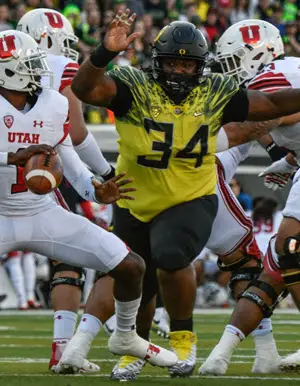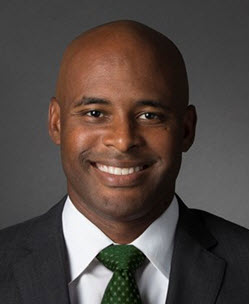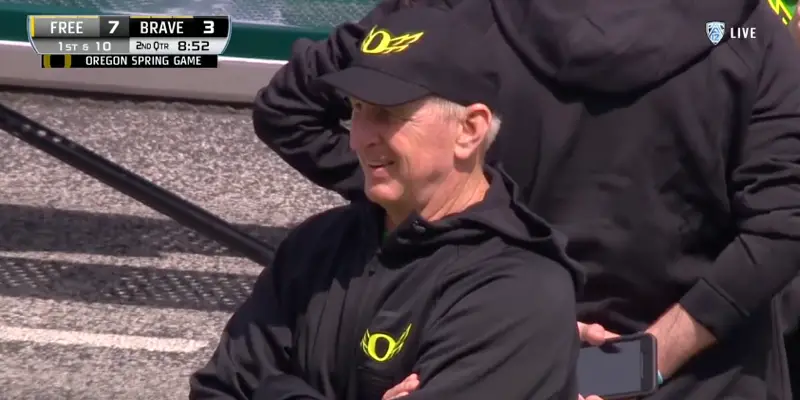Being that I live in Oregon (though not a Duck fan myself), I’ve had a sort of voyeur interest in watching both the collapse and rise of Oregon’s defense in recent years. For a decade and a half, the Ducks defense was guided by the adaptive hand of Nick Aliotti. Following his departure, Oregon enjoyed one more good year on defense before one of the most dramatic collapses I’ve ever seen in college ball. With the benefit of hindsight, it is clear that Aliotti’s presence was more critical than likely anyone – perhaps even Oregon’s own coaching staff – had previously believed.
Following the defensive disaster that was the 2016 season, Oregon snagged one of the better defensive coordinators in the Pac-12 in Jim Leavitt from Colorado. After his hire, the Ducks bounced back in a big way on defense, going from atrocious to fairly solid. But what intrigued me was the high-level of secrecy that surrounded Leavitt’s defense: beyond the fact that it was a 3-4, no one knew much of anything regarding the details of his scheme. And to the best of my knowledge, that has remained the case. So I decided to take the opportunity to analyze a defense that didn’t already have a lot written about it previously.
Basic Structure
Jim Leavitt’s defense, (below), is disguised simplicity. Operating on a 3-4 structure, Leavitt uses his ability to rush either outside linebacker – or even both or neither – to hide his intentions before the snap. This flexibility allows Leavitt to disguise what is an otherwise fairly straightforward coverage scheme. Leavitt’s central idea is to limit the information a quarterback can glean pre-snap and force them to make reads and decisions on the fly. And for the most part, that works. But a well-coached quarterback can, at times – like Stanford’s starting quarterback Keller Chryst did in 2017 – see through the disguise and capitalize on the built-in simplicity.

Leavitt’s basic alignment…
Before the snap, each outside linebacker (“D” and “O” above) will roam in the area between over the slot receiver, to the area on the outside edge of the tight end (or 9-tech even when no tight end is present). At the snap, each outside linebacker will drop into coverage or rush the passer from whenever they happened to be at the time the ball is snapped. This “roaming” technique sometimes leaves the outside linebackers out of position, but it does an excellent job of hiding their intentions.

Jordon Scott eats a lot of space…
While Leavitt’s defense is based on a 3-4 structure, the personnel is hardly that of a 3-4 defense from the 1990s. All of the linebackers on Oregon’s 2017 defense, even the inside ones, are closer in profile of a heavy-hitting defensive back then a bulky linebacker, prioritizing speed and quickness over size or strength. The outside linebacker on the field side – or the Duck in Leavitt’s terminology – will often operate in a similar role to that of a traditional nickel back.
And the outside linebacker on the boundary side isn’t much different. That it is because both outside linebackers are expected to both rush the passer and drop into coverage. This set up allows the Ducks to better match up against spread offense speed on the field, though the trade off in size does come with drawbacks against heavier personnel sets at times (see e.g., Oregon’s game versus Stanford).
On the defensive line, only the nose tackle fits the profile of a traditional two-gap, space-eater. The other two defensive line positions, while playing two-gap technique much of the time, do not quite fit that description. The Ducks were transitioning in 2017 from more of 4-3 defense, however, so it remains to be seen if recruiting in subsequent years will alter that trend. (At Colorado, Leavitt’s starting defensive line all weighed about 300 pounds.)
Leavitt has a strong emphasis on keeping his interior seven (defensive line and linebackers) in the box against the run. On most run-pass option plays (RPOs) and play-action, the interior seven would play the run, leaving the secondary to handle the pass options. This puts a lot of stress on the safeties and cornerbacks to hold up in coverage.

Keith Heyward
And Charles Clark – Oregon’s cornerback coach in 2017 (now at Ole Miss) – definitely lived up to his end of the bargain. Even when Oregon’s cornerbacks allowed completions – and they did at times – they were almost always in solid position on the receiver. (Clark was also the corners coach at Colorado under Leavitt, when both Chidobe Awuzie and Ahkello Witherspoon were drafted, so let’s say his resume checks out.)
In addition, Keith Heyward – Oregon’s safeties coach – also did a very good job of enhancing the play of the back-end. This marked a theme of Oregon’s defense in 2017: improvement was less a result of change in scheme so much as better execution of assignments and techniques.
This should give the reader a basic introduction to Jim Leavitt’s base defense. And over the next several weeks, we will go into greater detail, including covering Leavitt’s defensive fronts, coverages, and common blitzes. I hope, (before the season begins) to give Duck fans not only a clear picture of the Oregon defense for the upcoming season under Jim Leavitt, but also a better understanding as to why. See you next week when we dive into the Duck’s defensive fronts.
Cameron Soran
Hillsboro, Oregon
We will be featuring these analyses of Oregon’s 3-4 Defense on Tuesdays right up to the beginning of football season. It is in addition to our usual Mon-Wed-Fri. format of publishing articles, but it is well worth the learning experience for us all. Thanks to Cameron Soran, we will know so much more of what is occurring on defense this season! Charles Fischer
Cameron Soran is a practicing business attorney in Hillsboro, Oregon. While not a Duck fan himself, he is an avid fan and analyst of Pac-12 (and Notre Dame) football in his spare time. He is also a contributor at https://rileykolstefootball.com/. You can follow him on Twitter @cameronsoran

